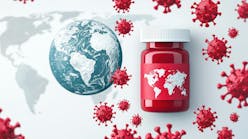COVID-19 presents antibiotic stewardship with challenges, opportunities
In the months since the novel coronavirus emerged in China and began spreading around the globe, reports of bacterial co-infections and widespread antibiotic use in COVID-19 patients has prompted concerns that the unprecedented viral pandemic, on top of the devastation it has already caused, could have the downstream effect of diminishing antibiotic supplies and further fueling rates of antibiotic resistance.
Even though COVID-19 is caused by a virus—SARS-CoV-2—and antibiotics should have no effect on it, those concerns are not unfounded. Clinicians have frequently had to resort to antibiotics for COVID-19 patients because of clinical uncertainty, the risk of secondary bacterial infections in patients with underlying conditions and lengthy hospitalizations, and most of all, a lack of any other proven treatment.
To date, the picture on antibiotic use in in COVID-19 patients is incomplete but worrisome. An early study from Wuhan, China, where the pandemic originated, indicated nearly all hospitalized patients were receiving antibiotics. A recent review of COVID-19 studies published since the pandemic began found that while only 8 percent of COVID-19 patients had documented bacterial co-infections, 72 percent had received antibiotic therapy.
Clinicians in the United States say that, in the face of a pathogen that causes what looks like a typical case of pneumonia but can cause patients' conditions to deteriorate quickly and lead to other bacterial infections in some severely ill patients, antibiotics are at least a known quantity, even if they're unlikely to help.
But conversations with these clinicians and others who have been treating COVID-19 patients suggest that even in the face of the initial surge of coronavirus infections, antibiotic stewardship principles have helped guide as much appropriate use as possible. And they believe those principles will help limit antibiotic use as the pandemic continues.
For Debbie Goff, PharmD, a pharmacist who specializes in infectious diseases and antibiotic stewardship at The Ohio State University Wexner Medical Center in Columbus, the amount of antibiotic prescribing occurring in COVID-19 patients is understandable but frustrating.
"I really can't fault them [clinicians] for trying to do whatever they can," Goff says, because the mortality rate of COVID-19 is frightening, and they have little else to work with. “But the antibiotic prescribing is going on almost across the board in COVID-19 patients because we lack the ability to diagnose bacterial infections rapidly. This is why we need respiratory rapid diagnostic tests in U.S. hospitals."
Goff hopes that now that cases appear to be slowing down in the United States, hospitals can go back and look at data on COVID-19 patients to see how many received antibiotics and how many got bacterial or fungal co-infections and identify the factors that put COVID-19 patients at risk for those infections.
At this point, there is little current data to indicate how antibiotic use in COVID-19 patients is impacting antibiotic use nationwide. Shortages of the antibiotic azithromycin have been reported to the U.S. Food and Drug Administration (FDA), likely because of the use of the drug with the antimalaria medication hydroxychloroquine, a combination that showed some promise in reducing SARS-CoV-2 viral load in a small French study and has been widely adopted, despite little evidence of benefit in COVID-19 patients.
Regardless of how COVID-19 is impacting current antibiotic use, people who've been warning about the crisis of antibiotic resistance and the lack of new antibiotics to treat multidrug-resistant pathogens say the pandemic highlights the need to be prepared for the emergence of an infectious disease, whether it's viral or bacterial.
"Seventeen years ago, when I was leading the CDC, we worried about antibiotic resistance complicating the care of SARS patients," former CDC Director Julie Gerberding, MD, now with pharmaceutical company Merck, wrote recently. "We knew then that America's arsenal of antibiotics was not sufficient to guarantee we could manage a large outbreak of drug-resistant bacteria. Since then, these bacteria have only become more widespread, more deadly, and far more difficult to treat, yet our stable of antibiotics to manage them has barely increased."





